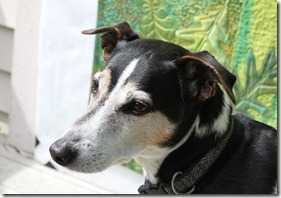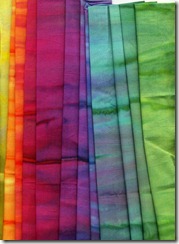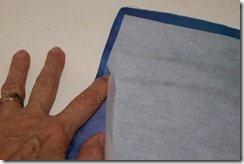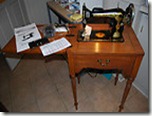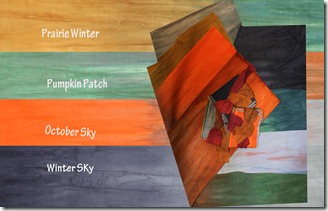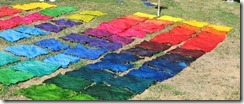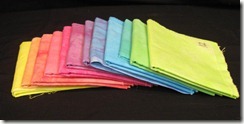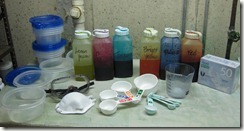Let’s get started with our project my pattern “Star Lilies”.
Star Lilies was inspired by the Star Lilies in my garden. I love them and they come in such bright and wonderful colors unlike regular day Lilies that I also have in my garden.
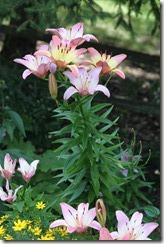
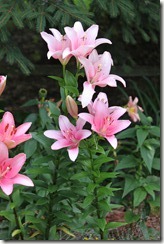
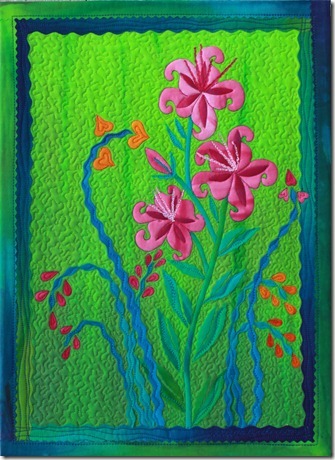
Star Lilies 14” x 16”
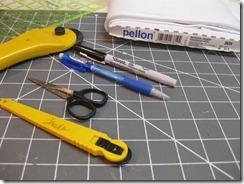
These are the basic tools I use to create my fused quilts. Wonder Under #805 from Pellon, rotary cutters, very sharp embroidery scissors and a mechanical pencil and extra fine sharpie marker.
I have used three different color gradations in this pattern, a lime to violet 1/2 yard piece of fabric that will be divided in half for the background and border. A skinny quarter yard gradation from orange to fuchsia for the flowers. And a skinny eight yard of blue to green for the leaves. I always fuse all my fabrics and then work from all the fused fabric, rather than constantly applying fusible to different areas of the fabric. And yes I have lots of fused scraps but I use them up.
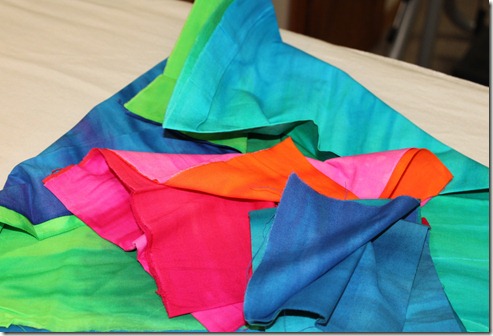
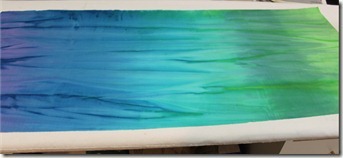
Start with beautifully ironed, wrinkle free fabric. This gradation from violet to lime will act as the background and borders for my little quilt. This is a 1/2 yard of fabric. The way I dye fabric it leaves color lines in the fabric and to me it looks like the fabric has been created by water coloring it. Gorgeous isn’t it, I love working with these gradations and color blends, they add so much depth and movement to my work.

I am applying the WonderUnder #805 to the back side of the fabric (with dyed fabric there really is no back side of the fabric) notice the steam is turned OFF on my iron.
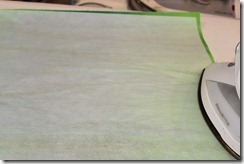
I always make sure that my WonderUnder is cut so it is smaller than my fabric. I don’t want any edges of fusible sticking out to get sticky stuff on my ironing surface. I’m going to talk about cleaning your iron in another post.
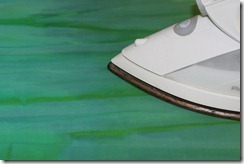
I iron all my edges really well on the back side and then turn it over to the front and iron it flat from that side too. If you have a steam iron sometimes it can leave air bubbles on the front of the fabric, just iron them out on the front of the fabric.
TIP -When I am ironing I push down on the iron and apply pressure as I go to help the fusing process.
Then let the fabric cool, go to the bathroom or something, give it a rest already.
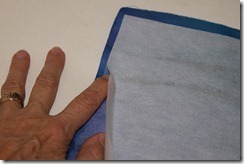
When I go to peel up the paper, I start at one end and run my finger down the length of the paper to separate it from the fabric. My good bud Laura taught me this trick.
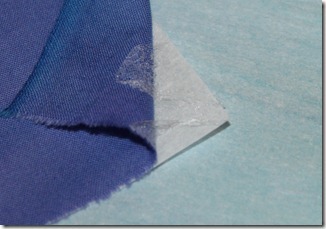
If when you are removing the paper from the fused fabric and the fusible starts to peel up with the paper you didn’t get the fusible hot enough. Go back with the iron and heat it again, AND let it rest again. Patience is a virtue.
I am going to peel off the release paper from the half yard of my gradated hand dyed fabric. I will save the paper, this is what is called release paper.
TIP -I almost ALWAYS work without paper on my fused fabrics so I will get clean crisp cuts that stay that way.
I am going to cut the release paper into two sections and use them for two different purposes. When I peel it back if I place one hand on the left and use the other hand to basically roll the paper back it should peel away very nicely. Especially if I have let the fused fabric rest.
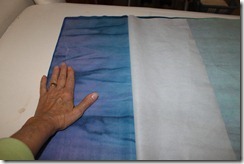
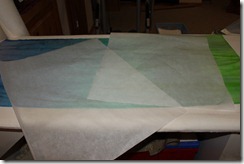
I will use each section of paper for different things.
The first thing I do is cut out my background area fabric. I will cut from the lime and green end of the 1/2 yard of fabric a piece of fabric about an inch bigger than the finished piece quilt, so about 15” x 17”, and place it back onto a piece of release paper. I tack fuse it to the paper. Tack fusing is lightly ironing it so it stays put on the paper. I can refuse to the release paper or parchment paper over and over again and it doesn’t matter which side of the paper I use.
![image_thumb[5] image_thumb[5]](http://lh3.ggpht.com/-lSm9MYBRRYs/ToI_qK5M3cI/AAAAAAAAO68/EMZU7l4cuzY/image_thumb5_thumb.png?imgmax=800)
![image_thumb[6] image_thumb[6]](http://lh5.ggpht.com/-YEGGYnRdbzA/ToI_rQuFbFI/AAAAAAAAO7E/jhl6muHibKg/image_thumb6_thumb.png?imgmax=800)
I want to draw with a pencil the exact size of the background on my fabric. I will use this as a guide later when I add in the border. I will set aside the other half of the hand dyed fused fabric from this half yard and use it later to do several things.
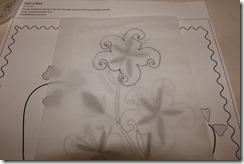
I place the other half of release paper over my pattern and using either a mechanical pencil or a black extra fine sharpie marker I am going to trace my design elements. I use a mechanical pencil when this tracing will be placed on light colored fabrics like yellow, pink or pastels and I use the marker when it will be placed on blues, greens, browns or dark colored fabrics.
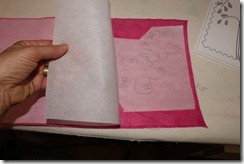
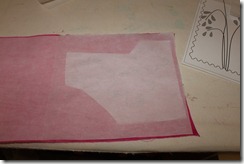
I have used a piece of fabric for all the flowers in this pattern that grades from fuchsia to orange. I fused this piece of fabric and then I will peel up the release paper on one end but leave it in place. I will place the tracing of the star lilies marker side against fused side of the fabric. I have rough cut out three star lily shapes and I want to protect my iron from getting fusible on it. So I let the release paper fall back in place and then press again with a hot dry iron. The marker or pencil will PRINT to the back side of the fused fabric. Ta Da, It’s a miracle. When it has cooled I will peel away the paper and cut right on or just inside the marker line to cut out my designs.
I repeat this process for all my design elements that I want to trace.
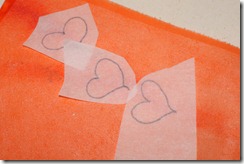
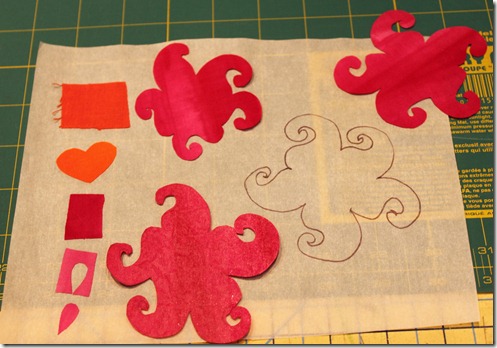
When I cut out shapes like the hearts or buds rather than tracing these small pieces I free form cut them. First I cut out a square a bit larger than the final shape and then with my sharp embroidery scissors I can cut out my little shapes.
As I cut out design elements like the flower heads and the hearts for the vines I can lay them on top of the background fabric.
Next I want to make the stems and leaves for the flowers. I will use the other half of the gradated fabric, the blue to aqua end, to create these. The first thing I want to do before cutting out leaves and stems is to cut out the binding for this project. It comes from the aqua to blue end of the fabric and I want to make sure I have it cut and set aside before I cut the leaves and stems from the rest of this piece of fabric.
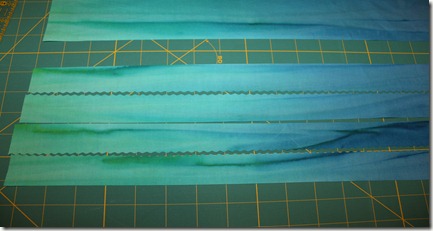
I love using decorative rotary blades in my fused projects and will use two or three different ones in one project. I have used the pinking blade in my 45 ml rotary cutter to cut out the binding for this quilt. These measure 1 1/4” x 18” each. I drape them over a chair to keep them safe and un-creased.
Now I will cut out stems and leaves.
The first thing I do is cut out my stems, I do these first so that I get my long thin pieces out of the fabric before I start cutting out the leaf shapes. I am going to use a straight blade and a decorative blade to do this.
The first stems for the flower itself are cut using my straight blade and a ruler. These are about 1/4” wide. The stems for the hearts and buds are cut using a wavy blade in my rotary cutter.
TIP- I keep all my decorative blades in their own handles. You will use these fun blades a lot more if you have them already in their own handles.
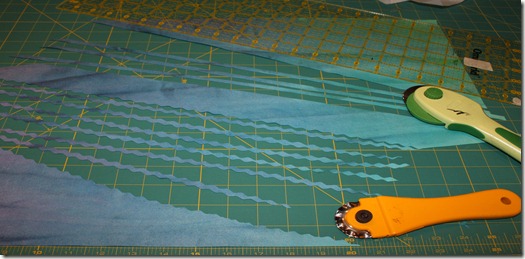
When I cut long skinny stems and veins etc I cut these on the bias. This keeps the edges from fraying and allows me to curve them when I fuse them in place.
TIP - When using decorative blades always use an old cutting mat or turn your mat over to the back side because the decorative blades can scar your mat.
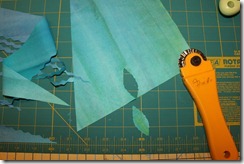
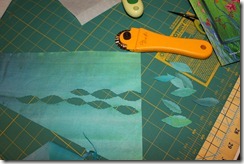
Then with the rest of that piece of fabric I free form cut out my leaves using a deckle blade in the rotary cutter. Of course you can cut all these things with just a straight blade. I try to cut as much as I can with my rotary cutters rather than scissors because I will get cleaner smoother cuts that will stay that way.
There is one more piece of fabric in the fabric kit with this pattern. It is a dark blue to green gradation for the border. I fuse this fabric and remove the release paper and cut four strips that are 2” x 18” to add the border on this quilt. I used the wavy blade in my rotary cutter to make these cuts. Again I did this on the back side or on an old cutting mat. I just keep this old green mat on the surface of my work table over my other larger cutting mat because I use decorative blades so often in my work.
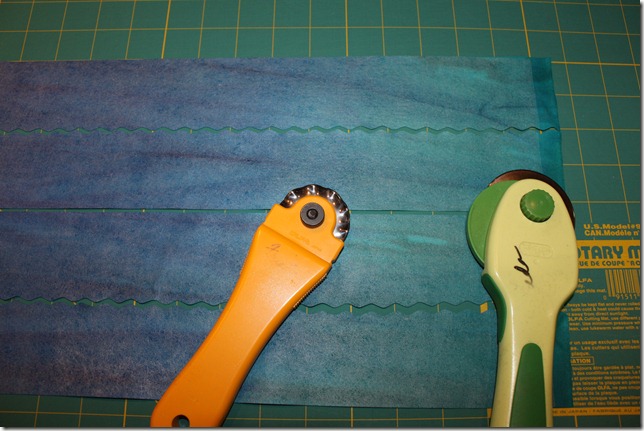
Next time we will assemble the quilt and quilt it.
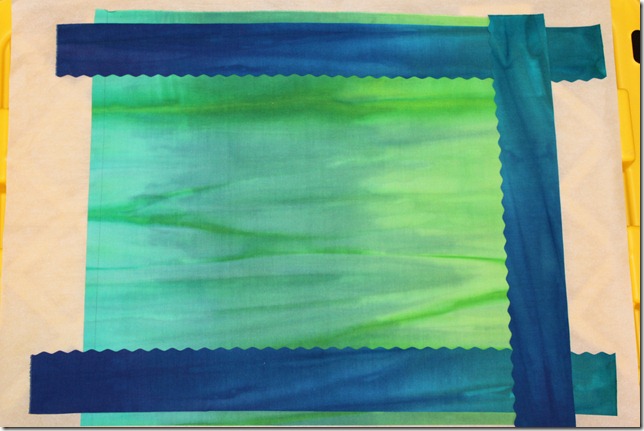
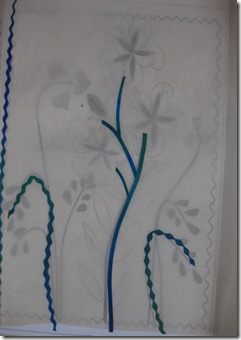
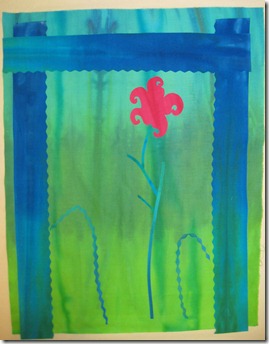
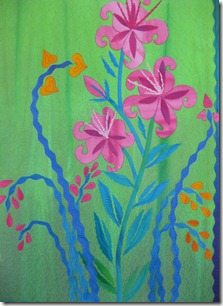
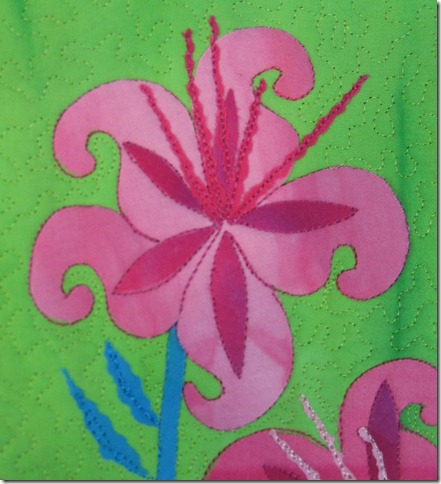 I like to stitch in the ditch right next to not on top of most of my designs like the stems and flowers. I like to do this in 30# rayon thread.
I like to stitch in the ditch right next to not on top of most of my designs like the stems and flowers. I like to do this in 30# rayon thread.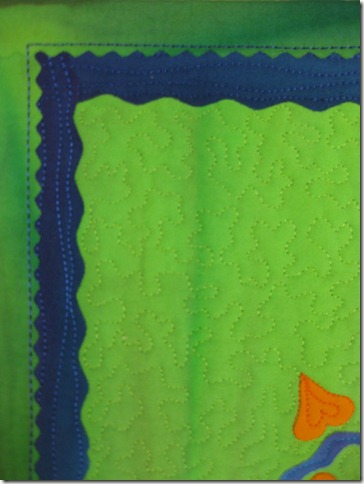















![image_thumb[5] image_thumb[5]](http://lh3.ggpht.com/-lSm9MYBRRYs/ToI_qK5M3cI/AAAAAAAAO68/EMZU7l4cuzY/image_thumb5_thumb.png?imgmax=800)
![image_thumb[6] image_thumb[6]](http://lh5.ggpht.com/-YEGGYnRdbzA/ToI_rQuFbFI/AAAAAAAAO7E/jhl6muHibKg/image_thumb6_thumb.png?imgmax=800)










